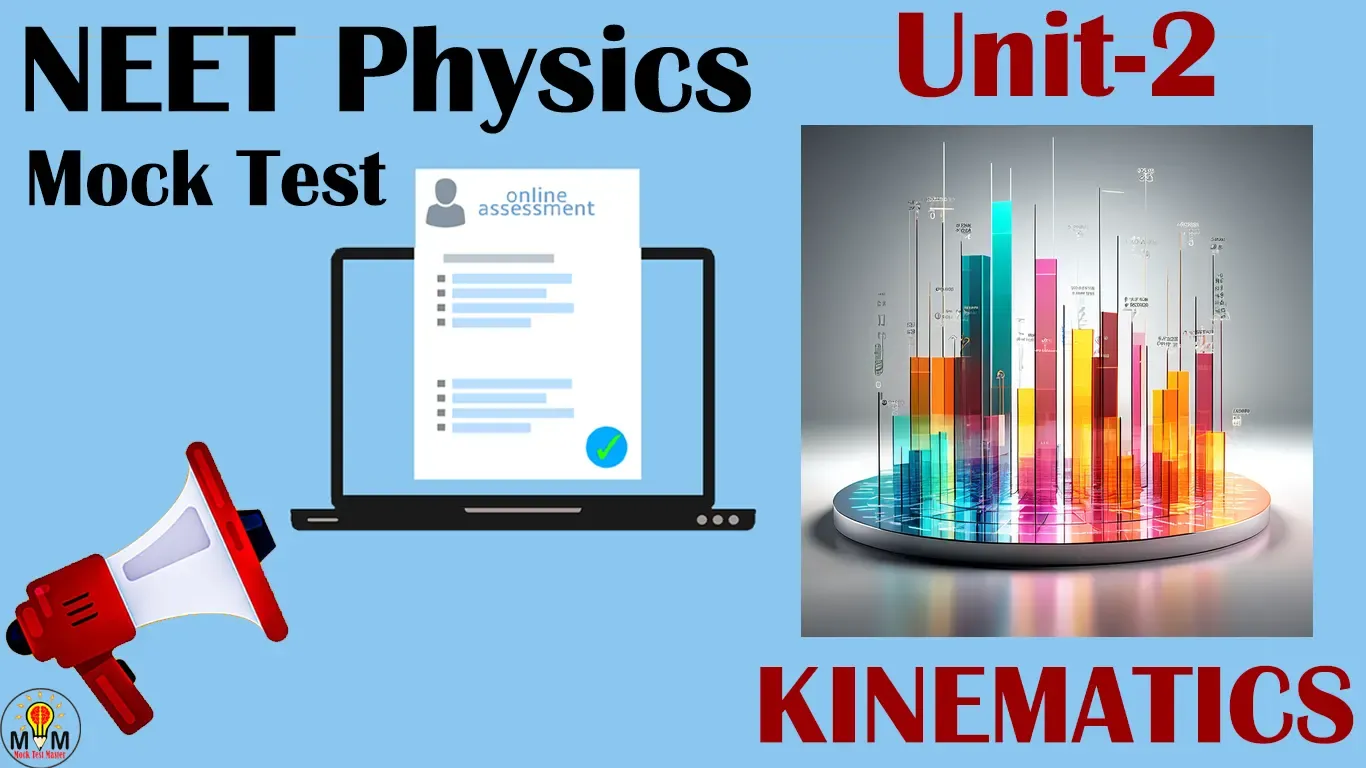In the journey
of preparing for the NEET exam, mastering physics is paramount. Among the
various units, Unit 2 - Kinematics - holds significant importance as it lays
the foundation for understanding motion and its mathematical descriptions. To
excel in this section, it's essential to grasp the concepts of displacement,
velocity, acceleration, and their graphical representations.
In this
comprehensive guide, we'll explore NEET Physics Unit 2: Kinematics in detail
and provide practice Multiple Choice Questions (MCQs) to aid your preparation
for the exam. MCQs on NEET Physics Unit 2 Kinematics cover all topics and
questions with answers that are given in the latest Physics syllabus for the NEET
Exam.
Syllabus of
NEET Physics Unit 2: Kinematics
The frame of
reference, motion in a straight line. Position- time graph. speed and velocity.
Unifonn and non-uniform motion. average speed and instantaneous velocity.
Uniformly accelerated motion. velocity-time, position-time graph, relations for
uniformly accelerated motion- Scalars and Vectors, Vector: Addition and
subtraction, scalar and vector products. Unit Vector, Resolution of a Vector.
Relative Velocity. Motion in a plane, Projectile Motion. Uniform Circular
Motion.
Understanding NEET Physics Unit 2: Kinematics
Unit 2,
Kinematics, deals with the study of motion without considering its causes. It
encompasses topics such as displacement, velocity, acceleration, equations of
motion, projectile motion, and relative motion. Mastery of these concepts is
crucial as they form the basis for solving complex problems in mechanics and
other branches of physics.
Key Topics Covered in Unit 2
1.
Displacement and Distance: Understanding the
difference between displacement and distance traveled is fundamental in
kinematics. Displacement refers to the change in position of an object, whereas
distance traveled is the total length of the path covered.
2. Velocity
and Speed: Velocity is a vector quantity that
denotes the rate of change of displacement concerning time and includes
direction, while speed is a scalar quantity that represents the rate of change
of distance traveled.
3.
Acceleration: Acceleration is the rate of change of
velocity concerning time. It can be positive (speeding up), negative
(slowing down), or zero (constant velocity).
4. Equations
of Motion: These are a set of equations derived
from the definitions of displacement, velocity, and acceleration. They are used
to solve problems involving uniformly accelerated motion.
5. Projectile
Motion: Projectile motion involves the motion of
objects projected into the air and subject to gravity. It consists of
horizontal and vertical components of motion.
6. Relative
Motion: Relative motion deals with the motion of
one object concerning another. It involves understanding the concept of
frame of reference and how motion appears different from different frames.
MCQs on NEET
Physics Unit 2: Kinematics
Now, let's put your understanding of Unit 2 concepts to the test with the following set of multiple-choice questions:
1. Which of the
following is a vector quantity?
a) Distance
b) Speed
c) Displacement
d) Time
2. What is the
SI unit of acceleration?
a) Meter per second (m/s)
b) Meter per second squared (m/s²)
c) Meter (m)
d) Second (s)
3. A car accelerates
uniformly from rest to a velocity of 20 m/s in 5 seconds. What is its
acceleration?
a) 2 m/s²
b) 4 m/s²
c) 5 m/s²
d) 10 m/s²
4. Which of the
following equations represents the relationship between displacement (s),
initial velocity (u), final velocity (v), acceleration (a), and time (t) for
uniformly accelerated motion?
a) \(v = u + at\)
b) \(s = ut + \frac{1}{2}at^2\)
c) \(v^2 = u^2 + 2as\)
d) \(s = vt - \frac{1}{2}at^2\)
5. In projectile
motion, the horizontal component of velocity remains constant throughout the
motion because:
a) There is no acceleration in the
horizontal direction
b) The horizontal velocity is unaffected by
gravity
c) Air resistance counteracts any changes in
horizontal velocity
d) The angle of projection remains constant
Answers:
1. c)
Displacement
2. b) Meter per
second squared (m/s²)
3. b) 4 m/s²
4. b) \(s = ut +
\frac{1}{2}at^2\)
5. a) There is
no acceleration in the horizontal direction
These MCQs are
designed to test your understanding of key concepts in Unit 2 - Kinematics.
Practice answering such questions to reinforce your knowledge and improve your
problem-solving skills.
Unit 2 -
Kinematics is a crucial part of the NEET physics syllabus, and mastering it is
essential for scoring well in the exam. By understanding the fundamental
concepts and practicing MCQs regularly, you can strengthen your grasp of
kinematics and boost your confidence for the exam. Incorporate mock tests and
practice sessions into your study routine to maximize your preparation efforts.
Stay focused, stay motivated, and success will follow in your NEET physics
journey!
NEET Physics Mock Test
- NEET Physics Mock Tests
- MCQs on NEET Physics Unit 2: Kinematics Test
- The questions are given in English language only
- You will get 60 seconds to answer each question.
- Know your score when the test is complete
Select the Mock Test
Mock Test Loadig Here
Back to Topics

Mock Test Result
Total Questions:
Answered:
Right Answer:
Wrong Answer:
Percent:
Share with Friends
Disclaimer: The accuracy of NEET Physics Unit 2 Kinematics multiple choice questions and answers cannot be claimed to be 100%. Please check the answers yourself. Typing errors may occur.





%20System.webp)
